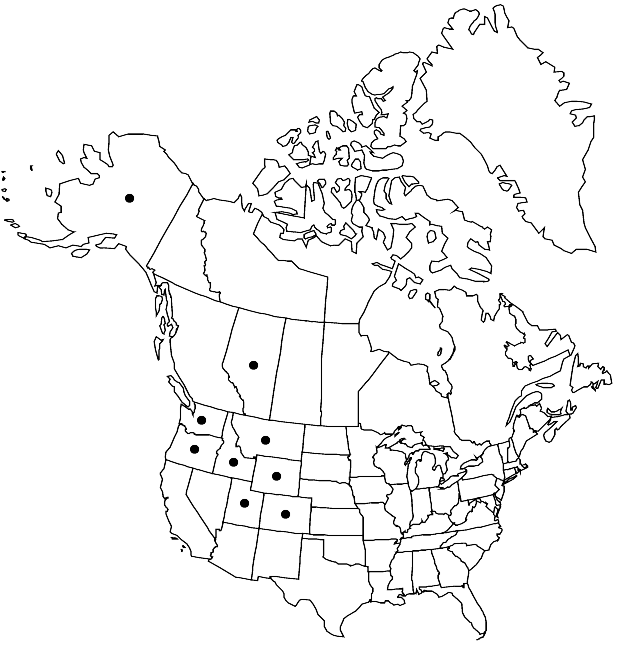Difference between revisions of "Boechera drepanoloba"
Harvard Pap. Bot. 11: 263. 2007.
FNA>Volume Importer |
FNA>Volume Importer |
||
| Line 14: | Line 14: | ||
|name=Arabis drummondii var. oreophila | |name=Arabis drummondii var. oreophila | ||
|authority=(Rydberg) M. Hopkins | |authority=(Rydberg) M. Hopkins | ||
| − | }}{{Treatment/ID/Synonym | + | }} {{Treatment/ID/Synonym |
|name=Arabis lemmonii var. drepanoloba | |name=Arabis lemmonii var. drepanoloba | ||
|authority=(Greene) Rollins | |authority=(Greene) Rollins | ||
| − | }}{{Treatment/ID/Synonym | + | }} {{Treatment/ID/Synonym |
|name=Arabis oreophila | |name=Arabis oreophila | ||
|authority=Rydberg | |authority=Rydberg | ||
| Line 35: | Line 35: | ||
|elevation=2000-3800 m | |elevation=2000-3800 m | ||
|distribution=Alta.;Alaska;Colo.;Idaho;Mont.;Oreg.;Utah;Wash.;Wyo. | |distribution=Alta.;Alaska;Colo.;Idaho;Mont.;Oreg.;Utah;Wash.;Wyo. | ||
| − | |discussion=<p>Morphological evidence suggests that Boechera drepanoloba is an apomictic species that arose through hybridization between B. lemmonii and B. stricta (see M. D. Windham and I. A. Al-Shehbaz 2007 for detailed comparison).</p> | + | |discussion=<p>Morphological evidence suggests that <i>Boechera drepanoloba</i> is an apomictic species that arose through hybridization between <i>B. lemmonii</i> and <i>B. stricta</i> (see M. D. Windham and I. A. Al-Shehbaz 2007 for detailed comparison).</p> |
|tables= | |tables= | ||
|references= | |references= | ||
| Line 59: | Line 59: | ||
|publication year=2007 | |publication year=2007 | ||
|special status= | |special status= | ||
| − | |source xml=https://jpend@bitbucket.org/aafc-mbb/fna-data-curation.git/src/ | + | |source xml=https://jpend@bitbucket.org/aafc-mbb/fna-data-curation.git/src/8f726806613d60c220dc4493de13607dd3150896/coarse_grained_fna_xml/V7/V7_516.xml |
|tribe=Brassicaceae tribe Boechereae | |tribe=Brassicaceae tribe Boechereae | ||
|genus=Boechera | |genus=Boechera | ||
Revision as of 17:58, 18 September 2019
Perennials; short- to long-lived; apomictic; caudex usually not woody. Stems usually 1 per caudex branch, arising from center of rosette near ground surface, 1–4 dm, glabrous or sparsely pubescent proximally, trichomes sessile or subsessile, 2- or 3-rayed, 0.1–0.3 mm, glabrous distally. Basal leaves: blade oblanceolate, 2–6 mm wide, margins entire, ciliate along petiole, trichomes (submalpighiaceous or simple), to 0.6 mm, surfaces sparsely to densely pubescent, trichomes subsessile, 2–6-rayed, 0.1–0.3 mm. Cauline leaves: 3–15, often concealing stem proximally; blade auricles 0.7–2.5 mm, surfaces of distalmost leaves usually glabrous. Racemes 5–25-flowered, usually unbranched. Fruiting pedicels horizontal to ascending, straight or curved, 4–8 mm, glabrous. Flowers ascending at anthesis; sepals glabrous or pubescent with scattered trichomes; petals purple to lavender, 6–8 × 1.5–2.5 mm, glabrous; pollen spheroid. Fruits horizontal to ascending, secund, straight to slightly curved, edges parallel, 3–5.8 cm × 2–3.5 mm; valves glabrous; ovules 44–76(–104) per ovary; style 0.05–0.5 mm. Seeds uniseriate, 1.5–2.2 × 1.2–1.6 mm; wing continuous, 0.3–0.7 mm wide.
Phenology: Flowering Jul–Aug.
Habitat: Rocky slopes and talus in alpine and subalpine habitats
Elevation: 2000-3800 m
Distribution

Alta., Alaska, Colo., Idaho, Mont., Oreg., Utah, Wash., Wyo.
Discussion
Morphological evidence suggests that Boechera drepanoloba is an apomictic species that arose through hybridization between B. lemmonii and B. stricta (see M. D. Windham and I. A. Al-Shehbaz 2007 for detailed comparison).
Selected References
None.